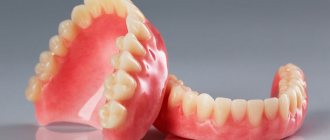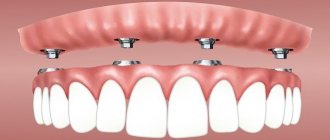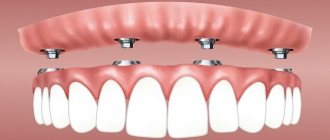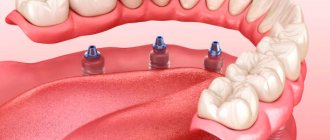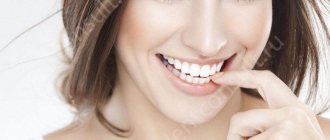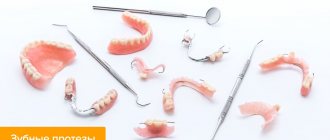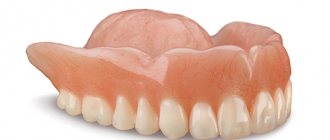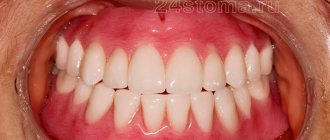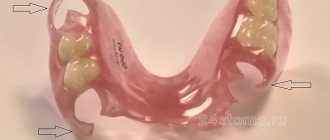- Complete removable dentures in Moscow
- Indications for use
- Types of removable dentures in complete absence of teeth
- Plate dentures for the entire jaw
- Removable dentures made of soft plastic
- Acrylic dentures for all teeth
- Removable nylon dentures
- Complete removable silicone dentures
- Clasp dentures for the entire jaw
- Pros and cons of complete dentures
- Preparation for prosthetics
- Manufacturing of complete removable dentures
- Fixation
- Care of complete dentures
- Complete removable dentures price
If we look at official statistics, almost half of the residents of our country by the age of 65 are faced with the problem of complete loss of teeth.
In medical practice, this phenomenon is called adentia. This situation should not be ignored, since edentia is not just an aesthetic defect that can cause psychological discomfort in the patient and affect self-esteem. Losing teeth is dangerous because it triggers a series of more serious health problems: the process of grinding food worsens, which leads to dysfunction of the digestive organs, impairs intestinal function, and as a result, the functioning of all internal organs is disrupted. The most progressive methods of restoring lost teeth are prosthetics on implants or the use of removable structures. Despite all the visible advantages of implantation, this method also has significant disadvantages. It may not be suitable for patients because it requires surgery, which may be contraindicated. And the second significant point is the high cost of all manipulations. An alternative, universal and suitable method of prosthetics for completely edentulous patients is the production and installation of removable orthopedic dental structures.
Removable dentures are distinguished by the fact that they can be removed and put on independently, at any time, without the involvement of specialists. There are two types of these structures:
- partially removable dentures;
- complete removable dentures.
Indications for use
As a rule, complete removable dentures are indicated for defects in a number of teeth, such as complete loss of chewing teeth. In addition, the pathological condition of the periodontium may be an indication. Severe periodontitis requires the installation of such structures; this will be the best solution for patients with this disease. The choice of the type of prosthesis depends on the specific case; the decision is made by the doctor together with the patient, based on a thorough examination of the oral cavity.
Fixing cream
Adhesive (fixing) preparations are available in the form of creams, powders or fiber pads. The most popular among them are creams that are produced on the basis of water-soluble polymer materials. They are easy to use, have additional antiseptic and aromatic properties and allow the patient to completely eliminate defects in the prosthetic device at the same time as more durable fixation. Manufacturers additionally add anti-inflammatory oils to some creams, which have a beneficial effect on the condition of the gums.
The principle of using a fixing cream is quite simple: immediately before applying the cream, you need to thoroughly rinse the prosthetic device and brush your teeth. Then a small amount of fixing cream is applied to the inside of the denture base. The device is placed on the teeth and pressed lightly for five to seven minutes. The adhesive preparation is completely compatible with biological tissues of the oral cavity, its composition is natural and does not cause allergies.
An essential feature that all patients need to be aware of is the condition of healthy gums. Any acute or chronic inflammation of the soft tissues of the oral cavity requires the owner of the prosthesis to temporarily refrain from using the orthodontic device and its fixing agents.
Types of removable dentures in complete absence of teeth
If there are no teeth left, the choice of design is significantly limited. Modern medicine offers the installation of prostheses on implants - this is the most reliable and most aesthetic method, but it is not available to everyone due to its high cost and indications. In this case, plate dentures remain - they are suitable for people of any age, if there are no allergic manifestations to the material used to create them. In the absence of teeth, all structures are similar in structure, but can be made of different materials. Let's decide what the pros and cons of different options are.
Plate dentures
Plate dentures, as the name implies, are a plate of different sizes. It acts as the basis of the structure, its basis. Fixing elements and artificial teeth are attached to it. Previously, such dentures were made exclusively from hard materials, but today dental technicians have a wider choice. This allows you to select products individually for patients, based on their needs and financial capabilities. But here it is necessary to remember that the material affects not only the comfort of wearing a denture, but also its service life.
Soft plastic dentures
Thus, acrylic products are considered the most durable. But since they are not always comfortable to wear, the formula of the material has been refined and improved. Complete removable dentures made of soft plastic were born. They are a combination of acrylic with the addition of additional components (for example, diamond chips). Their service life is very impressive, but due to their more plastic structure, they do not injure the gums, do not rub, and provide a tight fit.
Acrylic dentures
This type of prosthesis is the most popular - it is characterized by low price, aesthetics and ease of use. It consists of a base that covers the alveolar process and the body of the jaw, and artificial teeth attached to it. Before installing such a prosthesis, as in other cases, the oral cavity is first prepared for prosthetics, loose teeth are removed and the mucous membrane is treated, and then an impression of the jaws is made. Based on the impression, a primary model is created in the laboratory, which is adjusted and corrected after fitting. Acrylic or plastic prosthesis has the following advantages:
- an affordable way to completely restore teeth;
- ease of use;
- durability (7-9 years with proper care);
- uniform distribution of chewing load;
- quick adaptation period;
- lightness of the material, comfort of use;
- aesthetics and the ability to create a prosthesis that perfectly matches the color of natural gums;
- possibility of repair and correction;
- quick installation.
However, in order to decide which prosthesis is best to choose, you should know not only the advantages, but also the disadvantages of each type of design. For acrylic dentures, this is the possibility of an allergic reaction to the material, trauma to soft tissues during use, bad breath (acrylic is a porous material, bacteria can multiply in it), partial loss of taste, increased gag reflex, temporary impairment of diction and frequent need for correction. Most of these negative effects go away as you get used to the prosthesis, but some you have to put up with. To complete the adaptation period as quickly as possible, do not remove the denture at night.
Nylon dentures
The products are made from pink nylon, which is elastic and durable. They are similar to plate acrylic dentures, but differ from them in some parameters. This design perfectly imitates the gum and part of the alveolar process, it holds well and is suitable for sports enthusiasts. Such dentures are not removed at night even after the end of the adjustment period. A nylon prosthesis has the following advantages:
- hypoallergenic;
- high aesthetics;
- reliable fixation;
- low porosity, and, as a result, the absence of bad breath even after long-term use;
- flexibility, elasticity, comfortable use;
- durability (about 5 years);
- rare percentage of breakdowns.
The disadvantages of this type include the need for care of the prosthesis with the help of special means, the inability to repair in case of breakage, possible bone atrophy and mucosal injuries with prolonged use, uneven distribution of the chewing load (the flexible frame prevents this), the need for frequent correction and relatively high price.
In case of complete absence of teeth, implants are used to better fix the structure, and a metal arch is often used, which enhances the strength of the base. Thus, nyl dentures resemble dentures with a metal base and become even more durable.
Silicone prostheses
They are similar to nylon, but very different from them. Silicone is translucent; artificial – most often plastic – teeth are attached to a base made of it. Silicone dentures, as a rule, are used as temporary ones, because large gaps form between the teeth over time, and the service life of the structure is no more than two years, and it is rarely used for complete dentures. Their advantages:
- natural appearance;
- no allergic reaction;
- lightness and compactness;
- good fixation;
- softness of the material.
With prolonged use of the structure, atrophy of the alveolar bone and subsidence of the gums are possible, which is its significant drawback. In addition, they provide poor distribution of the chewing load and are difficult to maintain.
Clasp dentures
Clasp-type structures are practically not used in cases of complete edentia, since for strong fixation it will be necessary to create supporting surfaces. This requires additional time and financial expenses.
Method No. 2: on the patient’s natural teeth
A modern overdenture can be more securely fixed in the mouth if there are supporting teeth or preserved roots. This fastening option is possible to improve the fixation of removable appliances even if there are extensive defects1 in the dentition, and when only a few elements have been preserved that can become supporting ones. There are several mounting options available here.
A tooth-retained overdenture is also removable, but it is lighter and more compact than a design that is retained solely on the gums. It has a reduced palatal overlap, and sometimes there is no such overlap at all (for example, in sandwich dentures), which allows the patient to feel the taste of the food consumed. However, such devices contribute to rapid wear and destruction of the supporting elements of the row, because during operation they bear a serious load.
On clasps
Such overdentures are attached to the mouth using special hooks that tightly grip the supporting elements of the row. This is one of the most financially accessible, but not always convenient and aesthetic varieties. After all, hooks can be noticeable in the smile area. In addition, clasps can become loose and fail, which ultimately leads to instability of the entire system, displacement of the devices, and physical and psychological discomfort.
The photo shows a prosthesis with clasps
“I had to remove a couple of teeth. After that, for several weeks I agonized over the best way to restore them - with bridges or implants. I can’t decide on either one or the other... And money is still tight. And so my doctor advised me to temporarily install the covering apparatus on hooks, saying that it was inexpensive and there was no need to sharpen my teeth for it. I agreed on the condition that while I was wearing it, I would calmly make a choice and save money for a normal treatment option.”
LenaElena, review from 32top.ru
On attachments or clasps
One part of the fastening is installed in the abutment tooth or root, and the second is installed in the base of the removable product - the two elements are simply combined and snapped into place. This method of fixation significantly increases the stability of the structure and also improves its performance characteristics. The overdenture with clasps is compact and lightweight. The patient no longer has to take it out of his mouth every day. However, the price for it is much higher than for a product with hooks.
This is what a prosthesis with clasps looks like
Teeth cannot be used as support if they are severely damaged or inflamed, have cysts and granulomas on the roots, or are loose due to periodontitis and periodontal disease. They must first be cured, if, of course, they are treatable. In the latter case, that is, with periodontal diseases, the doctor can offer the patient a special splinting structure (clasp devices) with hooks that tightly grasp each loose element of the row.
Using telescopic crowns
When doctors offer patients overdentures attached to telescopic crowns, not everyone understands what it is. The design of such devices provides for the presence of several hollow crowns that are fixed to the supporting elements of a row, previously covered, again, with artificial crowns.
The photo shows a prosthesis on telescopic crowns
The connection of all components of the system into a single whole occurs according to the telescopic principle, when one crown is made slightly smaller in diameter than the other. As a result, the two fastening elements fit tightly onto each other, which ensures high quality fixation. The price of such products is quite high, because their production involves painstaking work and a high level of professionalism of the doctors who perform it.
Pros and cons of complete dentures
Such designs are very popular; they have many advantages, including:
- Strength and elasticity . Prostheses are comfortable to wear, suitable for patients of all ages and safe. They are made according to an individual impression.
- High aesthetics . It is possible to choose the shape and color of teeth and gums as close as possible to natural ones. All this is selected on an individual basis.
- Easy to care for . Such structures are easy to care for; sometimes you just need to rinse them in running water.
The disadvantages include the following features:
- relatively long adaptation period;
- insufficiently stable fastening;
- feeling of discomfort when laughing, coughing or eating;
- not very long service life;
- food restrictions;
- violation of speech functions;
- the need for preventive regular examinations by a doctor.
Fixing powder
It is made from sodium alginate, which contains natural substances that are biologically compatible with living gum tissue. The principle of using the powder is the same as that of a cream or fixing pad. A small amount of fixing powder is applied to the previously cleaned denture, the device is immediately put on the teeth and bonding occurs. Fixing powder, unlike fixing creams or pads, is usually available without aromatic or flavoring additives.
Preparation for prosthetics
An important role in the manufacture of high-quality, comfortable designs is played by preparing the patient for prosthetics. The doctor conducts a detailed examination of the oral cavity, identifies individual structural features of the maxillofacial apparatus, and determines the characteristic features of the jaws. At this stage, the material for creating the future structure, the optimal shape, size and color of artificial teeth are selected.
Individual spoons are used. The composition of the mass for impressions is also selected personally. Based on the casts, a model of the jaws is made.
The finished product is made from wax or plaster models. This is quite painstaking work and is carried out using special equipment. In this case, it is important to clearly maintain the distance between the teeth, the depth of their fixation, inclination and many other parameters.
When trying on dentures, the dentist identifies possible nuances that prevent a tight fit. All comments are sent to the laboratory, where a dental technician adjusts the design.
Manufacturing of complete removable dentures
The manufacturing process of both acrylic and nylon removable dentures occurs in several stages: taking impressions of the gums, casting a plate, welding teeth to it, and fitting the dentures to the patient’s jaws.
Acrylic dentures are produced by injection molding, and nylon ones are produced by hot injection under pressure. The latter method requires expensive modern equipment and qualified specialists who can work with such equipment. This has an impact on cost, and therefore nylon dentures are much more expensive than acrylic ones.
Price
- Primary appointment (examination, consultation) with a dentist (special offer) 100001
For free
Promotion
- Prosthetics with partial removable lamellar dentures (up to 3 teeth) 153001
9 900 ₽
- Prosthetics with partial removable lamellar dentures 153002
29 000 ₽
- Manufacturing of removable prosthesis Quadrotti 153006
59 000 ₽
- Prosthetics with removable clasp dentures 153007
59 000 ₽
Removable dentures without a palate are compact orthopedic structures designed to restore the integrity of the upper row of teeth. Traditionally, the upper denture is equipped with a palatal plate for vacuum fixation to the hard palate. Adaptation to such products lasts up to 3 weeks. Some patients cannot get used to it and refuse prosthetics, which reduces their quality of life. A removable denture without a palate is much smaller. The patient gets used to it in 7-10 days.
Care and storage
Dentures must be periodically removed from the mouth and cleaned. It's great if you do this every time after eating, but if this is not possible, you can rinse them in the morning and evening. Full dentures can be left in your mouth overnight, but it is best to remove them to give your gums a rest. In this case, before putting it in a special box, you need to thoroughly clean the prosthesis - rinse with boiled water, treat with an antiseptic solution or brush. It is recommended to have it professionally cleaned twice a year.
There is an opinion that the prosthesis should be stored in water or in a special solution. This is not so - a similar method was suitable for rubber prostheses, but modern technologies have made it possible to move away from it. Now it is enough to wrap the prosthesis in a cotton cloth and put it in a special box, where it will be protected from the sun, mechanical damage, heat and chemical influences.
Cost of complete removable dentures
| Name | Price from |
| Consultation with an orthopedic doctor | 500 rub. |
| Cost of complete removable dentures for both jaws | 60,000 rub. |
The cost of services is determined individually for each patient, since the individual characteristics of the patient’s oral cavity play a key role in the manufacture of structures. Factors such as the anatomical structure of the maxillofacial apparatus, the chosen type of structure, the material of its manufacture and methods of fixation, the shape and color of artificial teeth are taken into account.
Denta Labor dental laboratory produces complete removable dentures of excellent quality. Our laboratory has created all the conditions to produce high-quality prostheses with a long service life. You can check prices for removable dentures by phone 8 (495) 162-08-25.
Promotion! When paying in advance the full cost of making the prosthesis, the cost is reduced by 2000.
Cover structures – what are they?
In the classical sense, overdentures are removable appliances that get their name from the word “overdenture,” which literally means “overdenture” in English. That is, they usually cover, or more precisely, rest on the teeth and roots preserved in the mouth, or installed implants. In this case, the term “covering” is considered most appropriate.
Overdentures are removable appliances
However, today this is the name given to any removable systems. Even those that rest solely on the gums, when there are no teeth at all in the mouth. Experts justify this by the fact that in this case the structures are also covered, only not by implants and teeth, but by gums.
A dental overdenture can fill just one defect, can be partial (for partial and multiple edentia) or complete, when it is necessary to restore all the teeth on one/several jaws.
Now let’s look in more detail at what methods of fixing covering systems in the oral cavity exist.
